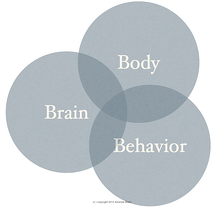In a recent issue of Training + Development magazine (February 2013), an article recapped research on what critical leadership skills were required to effectively lead a virtual workforce. Here are some of the highlights:
- Establish and meet metrics for work projects and goals

- Be extremely clear with goals and directions with a constant focus on the big picture
- Work with a high degree of complexity
- Promote organizational commitment
The article goes on to talk about the importance of effective communication, increasing feelings of connectedness, ensuring clear working protocols, and remaining focused on goals. In other words, virtual leadership is whole leadership.
By whole leadership we are describing an approach to leadership in which we develop all four energy patterns, as assessed by the FEBI coaching tool, so that we can utilize each when it's called for. Although we have preferences for which pattern we naturally use most, which we call the home pattern, we also have access to all four, and the ability to strengthen any of these patterns enough so we can use them when we need them.
Working with leaders of top companies around the globe, we find that the most successful leaders are those who can use any of the four patterns, and the right pattern at the right time. They have self-awareness of their natural pattern preferences, they know how to win on those strengths, AND they develop access to weaker patterns so that they can still be effective when the situation calls for something different than their typical, home-pattern repsonse. Although partial or short-term success is possible by developing and focusing only on one's natural style, each pattern is indispensable in the long run. Leaders need the
-
Driver’s focus, ensuring they clear barriers, motivate their people, and reach goals
-
Organizer’s stability, ensuring quality by building process, defining roles and responsibilities, and maintaining conscientiousness in everything they do.
-
Collaborator’s engagement, ensuring effective problem solving by seeing multiple perspectives, meeting people at an emotional level, and being fully engaged while engaging others.
-
Visionary’s expansiveness, allowing them to embrace the chaos, expand their world to all that is possible, and be more effective at strategic planning for the future.
Could you imagine a leader lacking any of these qualities?
Leading virtual teams and organizations is much like leading their face-to-face counterparts except more difficult, and so requires more focused effort to be successful. My dissertation research was on virtual team effectinesness, in which I studied real teams in real companies, all with real challenges. Virtual teams struggle more with building trust and maintaining full engagement. Their members make more cognitive errors (e.g., false assumptions), and share less information among themselves. These challenges result in less effectiveness when attention isn’t given to overcoming them. One reason for this added struggle is that virtual teams communicate in less feedback-rich ways, such as phone and email. When we, as the receiver, have less information from our communication mode (think facial expression and tone of voice), we tend to fill in the ‘blanks’ on our own. Personality is the lens through which we filter this information, which can get us into trouble when our filter is unknowingly distorted. Suddenly a short email response or an unanswered phone call makes us frustrated as we conclude that our co-worker is disengaged and unmotivated. In virtual communication we are more at risk of drawing a false conclusion because we tend to have less information in the communication mode. My research showed that simply helping people become self-aware of their own filter (i.e. personality or home pattern), reduces these errors and ultimately increases team effectiveness. We found that even one session of FEBI coaching led to a significant increase in virtual team effectiveness.
I would further argue that it's not just any coaching but FEBI specifically that is best positioned to help increase virtual team effectiveness because of its whole leadership approach. As we saw in the list at the beginning of this article, whole leadership is equally as important to virtual leaders as well.
- (Organizer) Establish and meet metrics for work projects and goals
- (Driver) Be extremely clear with goals and directions with a constant focus on the big picture
- (Visionary) Work with a high degree of complexity
- (Collaborator) Promote organizational commitment
You see, virtual leadership is whole leadership!
Want to learn more about how to use FEBI to develop teams? Join us on June 8th for our upcoming free webinar. Click the link below to register.



 imaginations. You would be mistaken. I am actually describing a typical Saturday morning for my wife, Jennifer. No, Jennifer is not from a magical land, nor a figment of my own imagination. Come Saturday morning, Jennifer is a gamer. Her games of choice are always of the creative, whimsical and playful variety. I already know what some of you are thinking: What a waste of time. Isn’t Nintendo for children? I would postulate that not only should we play and have fun, but that time spent doing so is of tremendous benefit to us. The more childlike and whimsical the better!
imaginations. You would be mistaken. I am actually describing a typical Saturday morning for my wife, Jennifer. No, Jennifer is not from a magical land, nor a figment of my own imagination. Come Saturday morning, Jennifer is a gamer. Her games of choice are always of the creative, whimsical and playful variety. I already know what some of you are thinking: What a waste of time. Isn’t Nintendo for children? I would postulate that not only should we play and have fun, but that time spent doing so is of tremendous benefit to us. The more childlike and whimsical the better!  Play is not only great for recharging your batteries outside of work, you can also engage this pattern at work, which makes work a lot more fun. The Collaborator pattern loves to have fun, to engage others, play in the give and take of relationships, and see both sides of a situation. Imagine how powerful this pattern could be if you need to engage your employees while navigating an organizational change, or to problem solve a complex issue. The Collaborator is often left out of the very situations where it is most needed. In such situations, especially if you normally approach them with the Driver’s urgency or the Organizer’s seriousness, you may need to be more intentional about summoning the Collaborator. But with a bit of practice, it will be easier and easier to do so.
Play is not only great for recharging your batteries outside of work, you can also engage this pattern at work, which makes work a lot more fun. The Collaborator pattern loves to have fun, to engage others, play in the give and take of relationships, and see both sides of a situation. Imagine how powerful this pattern could be if you need to engage your employees while navigating an organizational change, or to problem solve a complex issue. The Collaborator is often left out of the very situations where it is most needed. In such situations, especially if you normally approach them with the Driver’s urgency or the Organizer’s seriousness, you may need to be more intentional about summoning the Collaborator. But with a bit of practice, it will be easier and easier to do so.


 Here is how to get started. Take one of your brilliant ideas and write it down on a blank sheet of paper. Now, envision what it will be like for this idea to turn into reality. How is the world different? How is your idea/product being used? Really put yourself in that future of your idea. Now, summon your inner Organizer. Sit up straight, clean your workspace and put on some classical music. On your paper, write down several key things that would have to happen to make your idea a reality. Next, pick one of these things that you feel you can make headway on now, and write out a step-by-step list: how can you bring that about? Now, transfer this list to a calendar and hold yourself accountable to following through on these steps. It’s important to make these deadlines real for yourself, so if you are having a hard time following through, try telling a friend - sort of like an accountability buddyJ The Chinese philosopher Lao-tzu famously said, “A journey of a thousand miles begins with a single step.” With a little help from the Organizer, take that step today!
Here is how to get started. Take one of your brilliant ideas and write it down on a blank sheet of paper. Now, envision what it will be like for this idea to turn into reality. How is the world different? How is your idea/product being used? Really put yourself in that future of your idea. Now, summon your inner Organizer. Sit up straight, clean your workspace and put on some classical music. On your paper, write down several key things that would have to happen to make your idea a reality. Next, pick one of these things that you feel you can make headway on now, and write out a step-by-step list: how can you bring that about? Now, transfer this list to a calendar and hold yourself accountable to following through on these steps. It’s important to make these deadlines real for yourself, so if you are having a hard time following through, try telling a friend - sort of like an accountability buddyJ The Chinese philosopher Lao-tzu famously said, “A journey of a thousand miles begins with a single step.” With a little help from the Organizer, take that step today!


 Tell me about Stonewater Leadership.
Tell me about Stonewater Leadership. logical systems run right through your pelvic bowl. Your everyday posture actually plays a role in your resilience to stress.
logical systems run right through your pelvic bowl. Your everyday posture actually plays a role in your resilience to stress.





